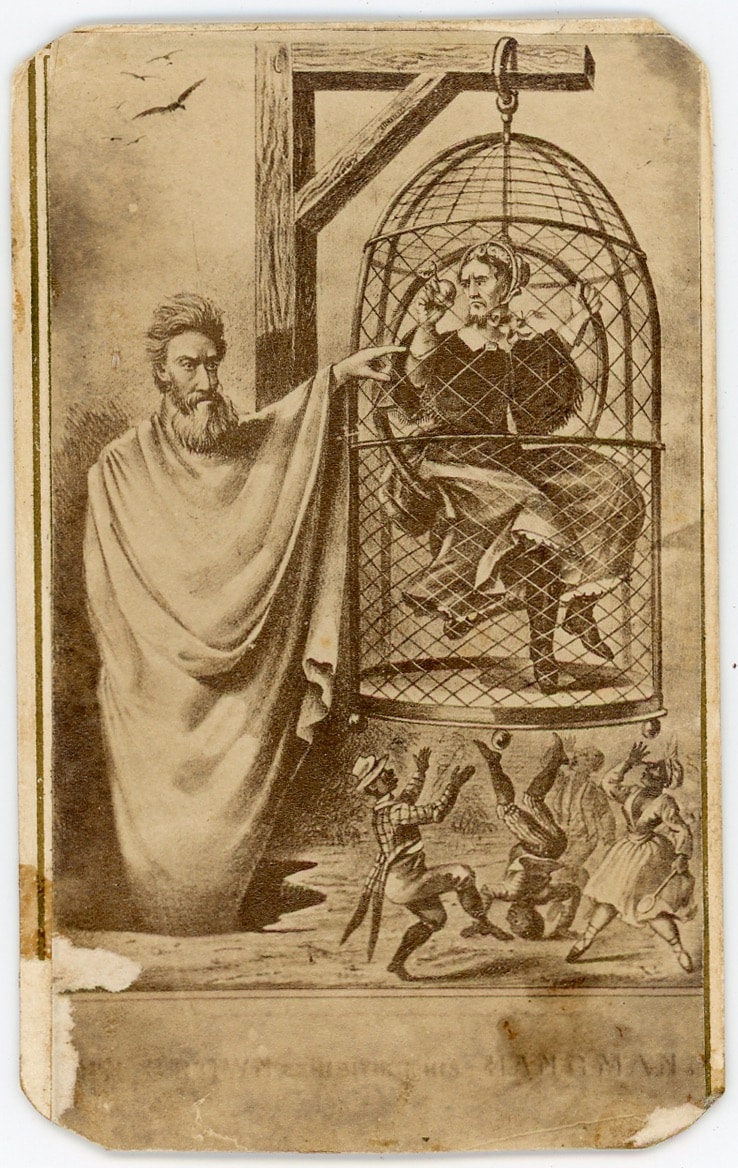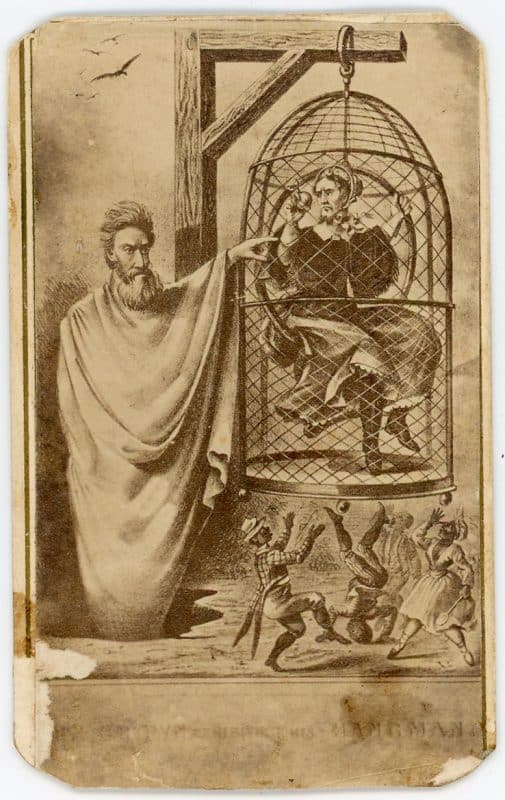The front of this 1860’s CDV Political Cartoon depicts John Brown Exhibiting His Hangman” Jefferson Davis who is dressed as a woman and in a bird cage.
Here are a few descriptions of the card from dealers: “Northern rejoicing at the end of the Civil War often took the form of vengeful if imaginary portrayals of the execution of Confederate president Jefferson Davis. Here abolitionist martyr John Brown rises from the grave to confront Davis, although in actuality the latter had nothing to do with Brown’s 1859 execution. Brown points an accusing finger at Davis, who sits imprisoned in a birdcage hanging from a gallows. Davis wears a dress and bonnet, and holds a sour apple. Since the beginning of the war Union soldiers had sung about ‘hanging Jeff Davis from a sour apple tree.’ Davis’s actual punishment was imprisonment at Fortress Monroe after his capture on May 10, 1865.
Below, black men and women, resembling comic minstrel figures, frolic about.
Davis appears to be wearing women’s clothing, a popular notion in the North, arising from the claim that in an attempt to escape from the Union Army, Davis dressed in his wife’s shawl.”
Back: written in pencil, faintly: “Jefferson Davids 1864”
Here is a segment from Stassa Edwards’s article: “Davises would only make it as far as south Georgia before they were found by Union troops.
According to a handful of accounts from the period, Davis was captured while wearing women’s clothes. The story, as it’s generally told, depicts a man desperate to escape and so, with the encouragement of his wife, Varina, he donned her overcoat and shawl and slipped into the Georgia swamp with a female servant (other accounts say he grabbed his wife’s coat and shawl accidentally). Union troops spotted the two “women” and, on closer look, realized that one was wearing spurred boots. Given away by his footwear, Davis surrendered to the Union troops.
The story of Davis in women’s clothing traveled quickly to the ears of Edwin Stanton, the Secretary of War. Stanton recognized the story as an opportunity to discredit Davis, who still had numerous sympathizers throughout the country. Historians have noted that the North gendered its victory as masculine and heroic and, in contrast, portrayed the South as feminine and weak. Davis’s flight played into that narrative, portraying the Southern leader as a coward willing to emasculate himself in order to escape. In short, manly martyrs do not wear women’s clothes. (Never mind that numerous eyewitness accounts disputed the story, including two by members of the First Wisconsin Cavalry, one of the units that captured Davis and his party and another by Davis’s coachman.)
Nevertheless, Stanton planned to exploit the account to the Union’s full advantage. But there was a slight hitch in his plan—namely, the look and style of Varina Davis’s overcoat and shawl. Mrs. Davis’s overcoat was essentially unisex, and bore a striking resemblance to the raincoats of Union soldiers. Furthermore, the shawl was also worn by many men in the mid-19th century, including Abraham Lincoln. The original plan foiled, Stanton encouraged the rumor that Davis had been captured wearing women’s petticoats, earning Davis the derogatory nickname “President in Petticoats.” “https://www.mentalfloss.com/article/84231/show-tell-photograph-jefferson-davis-womens-clothing



